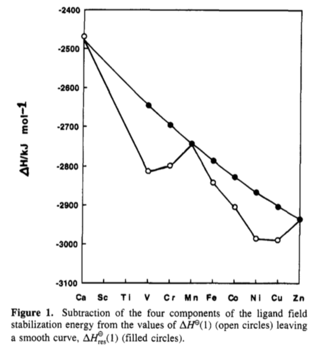To start off with, there are two graphs on the site you linked, the second one being this one:

This, as the author of your site also states, is a much nicer graph in that it explains all but two ions ($\ce{Cr^{II}}$ and $\ce{V^{II}}$) well.
I also went around and checked different crystal structures of hexaaquametal(II) complexes for their $\ce{M-O}$ bond length to see if that may have any influence. The results are:
Vanadium: $212~\mathrm{pm}$ (octahedral)
Chromium $203~\mathrm{pm}$ (axial) and $245~\mathrm{pm}$ (equatorial; Jahn–Teller distorted octahedron)
Manganese: $214$ to $217~\mathrm{pm}$
Iron: $211~\mathrm{pm}$ (almost octahedral)
Cobalt: $208$ to $213~\mathrm{pm}$ (distorted octahedron)
Nickel: Did not find data
Copper: $200~\mathrm{pm}$ (axial) $220~\mathrm{pm}$ (equatorial)
On the lower end of this spectrum we find copper and chromium which indeed have rather low $\mathrm{p}K_\mathrm{a}$ values. This could be due to a shorter $\ce{M-O}$ bond meaning that the water molecules experience the charge stronger. (This is also why I favour the graph I put in this answer: It puts copper closer to ‘where it should be’ in ionic radii terms.)
A second thing to consider is the ligand field stabilisation enthalpy LFSE. This is strongest ($-12~\mathrm{Dq}$) for vanadium since that ion only has three electrons which all occupy the lower energy levels. This would mean that ligand exchange for $\ce{[V(H2O)6]^2+}$ is kinetically strongly inhibited especially for vanadium, since any loss of a ligand would need to overcome the stabilisation of $-12~\mathrm{Dq}$. Hence, the water molecules are strongly bound to vanadium and experience its charge all the time. On the other hand, copper has rather weakly bound ligands exemplified in how simple it is to create $\ce{[Cu(NH3)4(H2O)2]^2+}$, the deep blue tetraammincopper(II) complex.
(Note: I did not find any papers confirming or disputing this hypothesis, but I only spent a short time looking.)
Right after vanadium we encounter chromium. It only has an LFSE of $-6~\mathrm{Dq}$ — which is still pretty good, considering it all derives from unpaired electrons. Overall, I think this ion can be considered to be almost like vanadium(II) albeit a little smaller, with an extra electron and a shorter metal-water bond length which would explain its position.
Next up is manganese which looks as if it were the exception. But it actually isn’t. First off, its LFSE is $0$, thus water molecules can diffuse on and off as they see fit, therefore overall weakening the effect the ion’s charge has on them.
From iron onwards, we can again consider the water ligands bound slightly more tightly since there is again LFSE to be gained. However, remember that while the $\mathrm{t_{2g}}$ orbitals are non-bonding with respect to metal–ligand σ interactions, the $\mathrm{e_g}$ level is antibonding. We have a half-filled $\mathrm{e_g}$ level which will weaken the overall $\ce{M-O}$ bonds. This could not only explain the larger $\ce{M-O}$ distances of manganese and iron when compared to chromium but also their weaker acidity. (A weaker bond would also mean weaker charge transfer.) I suspect that this does not yet really matter for chromium due to its Jahn–Teller distortion being somehow favourable overall, and that chromium’s acidity stems from the closer water molecules.
From then on, the explanation seems rather simple, since the ion radii and the $\mathrm{p}K_\mathrm{a}$ are almost in a linear correlation. The question is how the ionic radii were deduced (which is none-trivial) and why they differ so strongly with the two sources the author of your linked site used.



